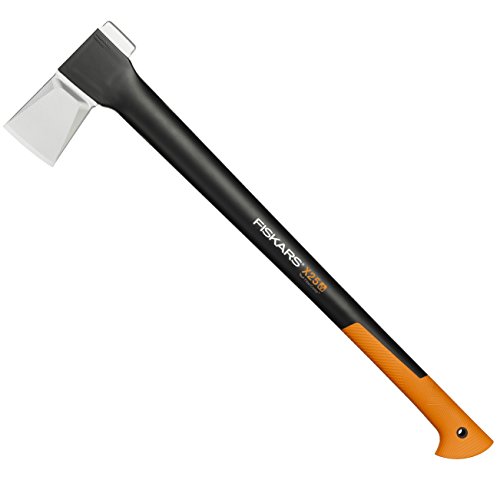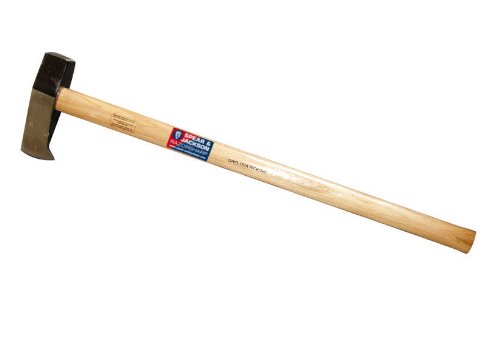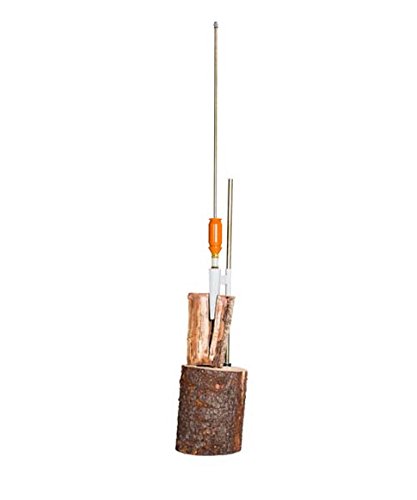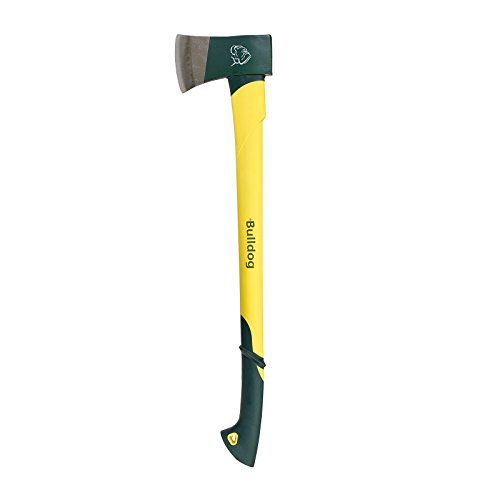We all love the festive season, especially the end of year holidays. It’s a time to eat, give, share, and most importantly, enjoy some time indoors with your family away from the cold; preferably near a log burner, fire pit, or chimney fire. Of course, the fire isn’t going to light itself – you’re going to need a lot of chopped wood to keep you and your family cosy all winter long.
Truthfully, splitting firewood and logs is not exactly the easiest or most glamorous job. It’s a tedious, time consuming labour that you might have to do every single day. But it’s also necessary, satisfying, and a cost effective way to heat your home and cook meals. And in the spirit of cost effectiveness, you’re not going to split wood with a chainsaw now, are you? Especially not when there’s an entire array of the best log splitting axes in the UK.
Most people make the mistake of thinking that a splitting axe is just a bit of steel attached to a wooden handle. But while the basic design for axes hasn’t changed much over the years, there have certainly been plenty of improvements.
Unlike the standard felling axe, today’s range of splitting axes are smaller, lighter, and specifically designed to split wood along the grain. They also have a tapered and weighted head to split and then separate the wood. Using the wrong axe can be quite frustrating and dangerous; use the guide below to find the most suitable one for you.
Key Considerations When Buying a Log Splitting Axe
a) Types of Splitting Axe
Splitting axes come is several different types to suit different purposes. Knowing exactly what you’ll be using the axe for should guide you towards the right type.
- A Basic Splitting Axe has a wider blade with a wedge shape meant to split down logs. The lighter weight reduces fatigue, but isn’t useful for chopping live wood and trees.
- Splitting Mauls are much more heavier and have longer handles and a blunt, mallet like head.
- Felling Axes are extremely sharp, heavy axes used to chop down live trees.
b) Consider the Weight
The weight of your splitting axe will dictate how long you can use the axe before getting fatigued. A heavy tool will produce more downward splitting force allowing you to chop through tough logs quicker.
However, the extra weight requires more power and strength to operate. So try to balance the weight vs comfort factor when picking out an axe.
c) Handle Length and Material
Same as the weight, the handle length also affects performance and comfort. A longer handle brings more force and momentum with each swing, but it also makes you tired faster. The material of the handle also matters. Most axes are made of wood while other handles come in fiberglass and plastic. All these materials offer great weatherproofing, so look out for grooves or anything that helps fortify your grip.
Best Log Splitting Axe Reviews
1. Fiskars XL X25 Splitting Axe

When it comes to axes, there’s really no one size fits all. People of different builds, strengths, heights and weights find different axes suitable. However, one company made a solid attempt at designing an axe that hits the sweet spot between weight and performance. Weighing in at 2.5kg, the Fiskars XL X25 Splitting Axe is a well balanced tool that is quite easy to use. And it all starts with solid construction.
At the top is a hardened, forge steel blade that has been designed to stay sharper for longer than the average splitting axe. But what really makes the Fiskars XL X25 Splitting Axe well balanced is the shaft. Fiskars used a FiberComp shaft that is super light but stronger than steel. This way, fatigue is kept at a minimum while retaining a virtually unbreakable frame. In addition to a textured, rubber grip at the end to prevent slipping, the anti-shock handle also reduces vibrations so you don’t overexert or injure yourself while working.
What I like about it:
- Virtually unbreakable FiberComp shaft
- Great balance of weight and comfort
- Designed to easily withdraw from wood
2. Draper Expert 09944 Log Splitting Maul

Whether you’re a committed active homeowner who likes doing things themselves or a professional who works with firewood on a regular basis, you can bet that Draper has just the right axe for the job. The Draper Expert 09944 Log Splitting Maul is one of their lightweight best sellers that avoids all the common mistakes some axe manufacturers make. For starters, the quality of the metal used for the blade determines how quick it goes blunt.
That’s why Draper used tempered carbon steel on the 09944 to make it extremely easy to sharpen. The handle also deserves a mention. This axe features a light fiberglass shaft that is also strong enough to handle all the day to day pressures of a modern axe. The overall low weight adds to the manoeuvrability giving users a much easier time splitting logs. The handle is topped off by rubber insulation to provide grip and shock absorption for all hand sizes.
What I like about it:
- Fine grain carbon steel head
- Light and strong fiberglass shaft
- Draper guaranteed splitting axe
3. Spear & Jackson Razorsharp Log Splitting Maul

Known for their high quality manufacturing and ergonomic designs, Spear and Jackson have been at the forefront of turning everyday gardening into an enjoyable experience. And looking at their precise, powerful and practical products, it’s safe to say they have succeeded. The Spear & Jackson Razorsharp Log Splitting Maul is a slightly heavier, slightly more affordable model built for handling tough and thick logs.
Weighing in at 3.6kg, this maul had been manufactured according to the internationally recognised DIN standards ensuring safety and durability. The splitting maul has a drop forged carbon head that has been tempered and hardened for even more durability. You’ll notice that the excess weight allows for cutting through thicker logs, but it might be heavy for people with a smaller build. However, the wooden hickory handle balances out the weight to make chopping even more comfortable. The addition of a hooked end at the blade means that users can split wood deeper and further without having to exert as much effort.
What I like about it:
- Heavier build for cutting thicker logs
- High quality hickory shaft
- Affordable price range
4. AGMA Swedish log Splitter

Not all splitting axes are actually axes. Today, there are all sorts of alternatives to the traditional swing and split axe. The AGMA Swedish log Splitter offers users the easiest and most importantly, safest way to split wood. This handy splitter will revolutionise the way homeowners chop and prepare their wood for heating and cooking. This Swedish patented invention is extremely easy to use and doesn’t take up much effort.
The AGMA Swedish log Splitter has a unique design that saves your back and shoulders from strain. That’s because it uses a bit of drilling and pressure to split wood instead of raw kinetic power. All you have to do is drill a small hole in the log you want to split, insert the splitter at the base, tighten the bolt with a wrench to securely fasten it into the log, and then lift the handle and place the log. Once everything is in place, lift the striking weight to drop up to 14 tons of pressure on the wood. No labour, no stress, and no dangerous swinging of a heavy axe.
What I like about it:
- Saves your back and shoulders from strain
- Safe and fun to use
- Delivers several tons of pressure for effective splitting
5. Bulldog BFA25LBGF Felling Axe

Like most homes in the UK, you probably just need a bit of firewood everyday for some festive heating. That’s why it doesn’t make sense for you to buy a lumberjack’s felling axe. If you’re just looking for a small hatchet to get the chores around the house done, then have a look at the Bulldog BFA25LBGF Felling Axe. Bulldog’s range of products have already been tried and tested since the 1780’s, so you can be sure you are getting an axe that exceeds British standards.
The Bulldog BFA25LBGF Felling Axe has been tested, bent, and impacted to make sure that it surpasses all quality and durability standards. Weighing in at only 1.6kg, the BFA25LBGF is extremely light allowing users to make quick work of their splitting chores. But don’t be fooled by the smaller size or weight of this axe – it’s as durable as they come. The manufacturer used one piece of hardened steel to make the forged axe head which is basically where all the weight is. The head is bonded to the handle with resin ensuring a firm, unbreakable bond. As for the shaft itself, it’s made from strong and ergonomic fiberglass that can withstand daily hammering into tough wood.
What I like about it:
- Incredibly light at 1.6kg
- Budget friendly price range
- No welds or weak points thanks to solid steel construction
Frequently Asked Questions
Q: How to sharpen a log splitting axe?
Even after one or two uses, your axe can get dull. Keeping it sharp will not only make your life easier, but will also increase the life of the blade. There are many things you can use to sharpen your axe – from rocks to specialist files – but this is the best way to sharpen a log splitting axe:
- Coat the axe edge, and the sharpening stone, with oil.
- Applying even pressure, rub one side of the axe with a whetstone.
- Use circular motions, and switch sides when the burr forms on the blade.
- Once the burr becomes less noticeable, switch to a finer grade whetstone and repeat the process.
- You can also use a grinder to sharpen your axe; this is a good method to use if you have an axe that hasn’t been sharpened in a while, or that has lots of damage to its blade:
- Clamp the axe in a bench vice so you have both hands free to hold the grinder.
- Position the axe so that the wheel of the grinder moves away from the axe’s blade.
- Follow the angle of the axe blade’s bevel, so that you don’t damage the blade.
- Sharpen one edge first, making sure that you don’t do too many passes over the blade as a grinder can take a lot of material away from the axe.
- Turn the axe and grind the other side equally.
- Clean off any burrs using a wire brush or wire wool.
After sharpening your axe, whichever method you use, it is a good idea to wipe the blade with a thin layer of lubricating oil, to keep it protected from rust.
Q: How to use a log splitting axe?
Assuming you are using a log splitting axe for chopping up rounds of wood, or for splitting large logs into smaller sizes suitable for your wood burner, there is a way that you should do it that will make it easier for you, and more effective.
- Firstly, you need to place the log you want to split on a suitable surface, This should be a sturdy, large chopping block such as a piece of tree trunk. Placing the thing you want to split onto a piece of concrete will not only jar your back, but it is also too low for you to get a good swing. Ideally, your chopping block should be somewhere a little below waist height, and it should be made of a forgiving material that will absorb the blow.
- Stand with your legs apart, and your knees slightly flexed. Hold the axe with both hands, your dominant hand (the one you write with) should be near the head, and your non dominant one towards the back of the axe.
- Lift the axe above your head, with your arms straight, then bring it down towards the log to be split.
- As you raise the axe, slide your dominant hand towards the back, where your non dominant one is. This will add weight to your swing.
- Swing the axe downwards in a smooth motion.
- In theory, the log should satisfyingly split in half at the point of impact – however this is often not the case. If you have a stubborn bit of wood, or if you have hit a knot, then you will need to dislodge your axe and repeat the process. Think of the benefit it is having on your biceps!
- If you have a log that refuses to split after a second, third or fourth go, then you may wish to employ a different type of axe, or even a wedge and a sledgehammer.
Q: Where to buy a log splitting axe?
Log splitting axes are one of those tools that everyone has an opinion about. You can try your local hardware store, or bigger department stores, or you can try a specialist axe supplier.
If none of these places deliver what you are looking for, then the internet is a treasure trove of axes – you are sure to find an axe that suits your needs online.
If nothing here suits then you might try going round various places that sell axes, because giving them a quick swing should determine whether they are suited to you.



